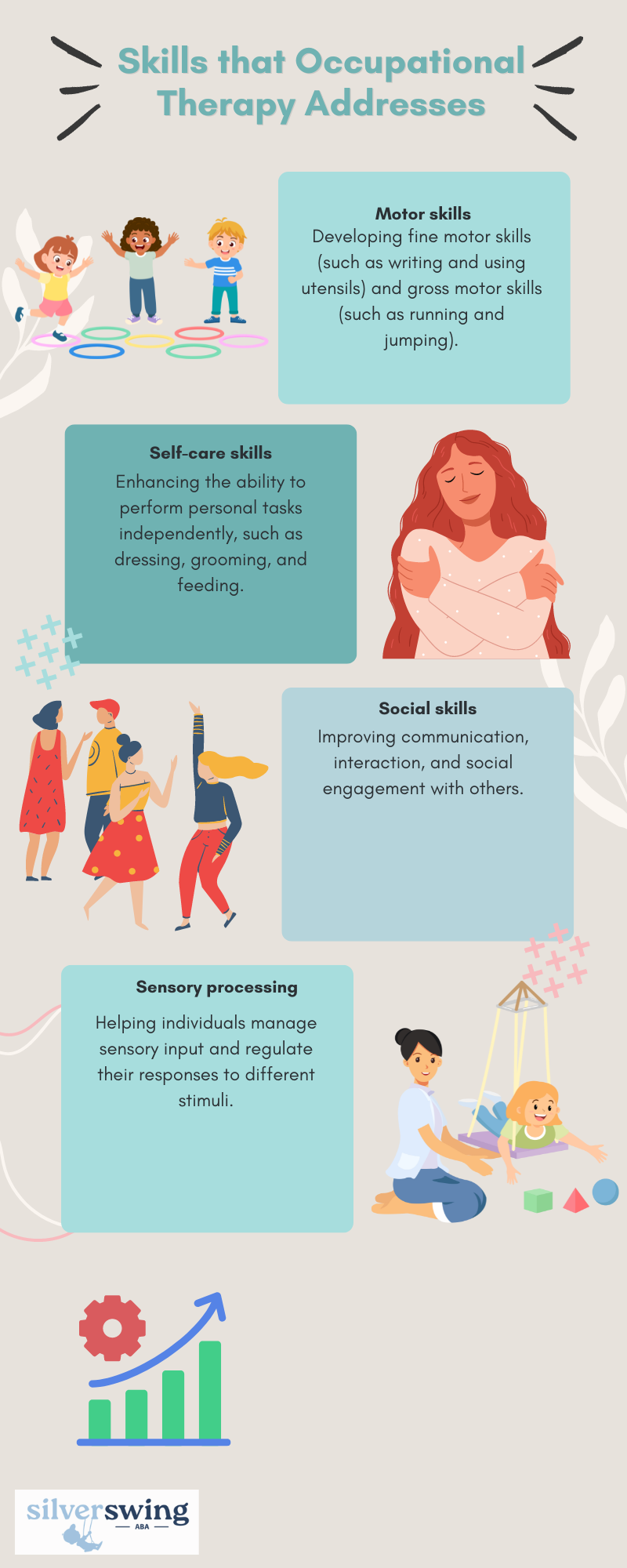Occupational therapy (OT) interventions have shown incredible promise in improving the functionality and quality of life for individuals with autism. Occupational therapists play a pivotal role in helping individuals with autism develop important skills and abilities that enhance their everyday lives.
In this article, we’ll look at various occupational therapy interventions that are designed for autism.

Importance of Interventions
Interventions provided by occupational therapists are crucial for individuals with autism. These interventions focus on addressing the unique challenges and needs of each individual, promoting their overall development and well-being.
Early intervention is particularly important as it can lead to significant improvements in the long-term outcomes for individuals with autism. Occupational therapy interventions can help individuals build essential skills, such as communication, emotional regulation, and problem-solving abilities.
These skills are vital for navigating daily activities, succeeding in school, and engaging meaningfully with others.
By targeting specific areas of difficulty and utilizing evidence-based techniques, occupational therapy interventions aim to promote independence, enhance social interactions, and improve the overall quality of life for autistic individuals.
Role of Occupational Therapy
Occupational therapy is a valuable tool in helping individuals with autism navigate their world more comfortably. Occupational therapists work closely with parents, teachers, and caregivers to set and achieve specific goals for the child. They assess the individual’s needs, strengths, and challenges to develop personalized intervention plans.
The main objective of occupational therapy for autism is to improve the individual’s overall functionality and independence in various areas of life. Occupational therapists address a wide range of skills, including but not limited to:

Through individualized therapy sessions, occupational therapists employ evidence-based approaches and strategies to address specific areas of concern and promote skill development.
Assessing Needs and Priorities
In order to provide effective occupational therapy interventions for individuals with autism, it is crucial to assess their needs and priorities. This assessment process involves the following:
Utilizing Assessment Tools
Occupational therapy assessments for individuals with autism often involve utilizing various assessment tools to gain a comprehensive understanding of their strengths, challenges, and priorities. These assessments help identify specific areas where occupational therapy interventions can be most beneficial.
Two commonly used assessment tools are the Canadian Occupational Performance Measure (COPM) and the Adolescent/Adult Sensory Profile.
The Canadian Occupational Performance Measure (COPM) is a client-centered assessment tool that focuses on identifying an individual’s perceived performance and satisfaction in everyday activities. It helps occupational therapists understand an individual’s priorities and areas where they may need support. By involving individuals with autism in the assessment process, their unique needs and goals can be addressed through targeted interventions.
The Adolescent/Adult Sensory Profile is another assessment tool that can be valuable in understanding sensory processing patterns in individuals with autism. This tool helps identify an individual’s sensory preferences and sensitivities, providing insights into their unique sensory experiences. Occupational therapists can use this information to tailor interventions that address sensory challenges and promote self-regulation.

Sensory Processing Patterns
Sensory processing patterns play a significant role in the lives of individuals with autism. Many individuals with autism may experience difficulties in processing sensory information, leading to challenges in everyday activities.
Occupational therapists employ various interventions, including sensory integration therapy, to help individuals with autism develop their sensory processing skills.
Sensory integration therapy is an intervention that focuses on helping individuals with autism learn to manage sensory input effectively. It can be particularly beneficial for individuals who experience sensory information overload or have underdeveloped sensory systems.
Occupational therapists use techniques within sensory integration therapy to address difficulties in processing sensory information, which can manifest as behaviors such as avoiding certain textures or becoming overwhelmed in noisy environments.
By understanding an individual’s sensory processing patterns, occupational therapists can design interventions that help individuals with autism build their sensory processing skills. These interventions aim to address difficulties associated with sensory processing and promote improved participation in everyday activities.

Effective Interventions
Occupational therapy offers a range of interventions that have proven effective in supporting individuals with autism. There are two commonly utilized interventions in this case which are:
Group-based Social Skills Training
Group-based social skills training has shown to be an effective intervention for individuals with autism. This intervention provides opportunities for individuals to learn and practice social skills in a supportive group setting. Through structured activities and guided interactions, participants can develop and refine their social communication skills, such as turn-taking, initiating conversations, and understanding non-verbal cues.
The group setting allows individuals with autism to engage with peers who may share similar challenges, creating a supportive environment for learning and growth. It also provides opportunities for social interaction and building meaningful relationships.
Group-based social skills training aims to improve social engagement, enhance communication abilities, and foster the development of friendships, which are essential for individuals with autism to navigate social situations successfully.
Cognitive-Behavioral Approaches
Cognitive-behavioral approaches have also shown promise in improving function in activities of daily living (ADLs) and instrumental activities of daily living (IADLs) for individuals with autism. These approaches focus on identifying and modifying cognitive processes and behavior patterns that may be hindering functional independence.
Cognitive-behavioral interventions involve helping individuals with autism recognize and understand the connection between their thoughts, feelings, and behaviors. By addressing cognitive distortions and teaching adaptive coping strategies, individuals can develop more effective problem-solving skills and improve their ability to navigate daily challenges.
These approaches can be particularly beneficial in improving executive functioning skills, self-regulation, and adaptive behaviors. By addressing cognitive and behavioral factors that may impact independence and quality of life, cognitive-behavioral interventions aim to enhance overall functioning and promote greater autonomy.
It’s important to note that the effectiveness of these interventions may vary depending on individual needs and preferences. Occupational therapists work closely with individuals with autism and their families to tailor interventions to specific goals and challenges, ensuring a personalized approach that maximizes outcomes.

Promising Strategies
There are also several promising strategies that can be utilized for individuals with autism. These strategies involve:
Interest-Based Clubs
Interest-based clubs can be a valuable intervention for improving social engagement and interaction in adolescents with ASD. These clubs provide a platform for individuals with autism to explore their interests, develop social skills, and enhance their overall well-being.
By participating in interest-based clubs, individuals with autism have the opportunity to connect with others who share similar interests. This shared interest serves as a common ground, fostering social interactions and providing a sense of belonging. Through regular participation in these clubs, individuals with autism can develop important social skills, such as turn-taking, active listening, and initiating conversations.
Interest-based clubs can cover a wide range of activities, such as art, music, sports, or hobbies. The key is to align the club’s focus with the individual’s interests, allowing them to fully engage and participate. These clubs often provide a structured and supportive environment, where individuals with autism can feel comfortable expressing themselves and building relationships.
Sensory Integration Therapy
Sensory integration therapy is an intervention that can be beneficial for children with autism spectrum disorders (ASD) who experience sensory processing difficulties. Sensory processing refers to how the brain receives and responds to sensory information from the environment. Children with ASD may have challenges in processing sensory input, which can impact their ability to engage in daily activities.
Sensory integration therapy aims to help children with autism learn to manage sensory input and develop better sensory processing skills. It involves engaging individuals in activities that provide sensory experiences in a controlled and structured manner.
This therapy can be helpful for children who experience sensory information overload as well as those with an underdeveloped sensory system.
By working with an occupational therapist trained in sensory integration therapy, children with autism can gradually learn to regulate their responses to sensory stimuli. This can lead to improvements in attention, focus, self-regulation, and overall participation in daily activities.
It’s important to note that while interest-based clubs and sensory integration therapy are promising strategies, the effectiveness may vary for each individual with autism. It is recommended to consult with a qualified occupational therapist to determine the most suitable interventions based on the specific needs and goals of the individual.

Enhancing Functionality and Quality of Life
Occupational therapy interventions for individuals with Autism Spectrum Disorder (ASD) aim to enhance functionality and improve the overall quality of life.
Occupational therapy interventions for adolescents with ASD can focus on areas such as daily living occupations, meal preparation, social skills development, and finding a job. The goal is to facilitate social and academic participation, enabling individuals with ASD to become more independent in their daily lives.
One of the key areas of focus is developing fine motor skills. Occupational therapists work with children with ASD to enhance their ability to perform personal tasks, such as buttoning, zipping, using utensils, and other activities related to self-care.
Through play-based methods, therapists help children improve the accuracy and speed of their movements, leading to increased independence and confidence.
Social engagement is also a significant challenge for individuals with ASD. Occupational therapy interventions play a vital role in helping individuals with autism develop functionality through different stages of their lives. By addressing the specific needs of individuals with ASD, occupational therapists can improve emotional regulation, communication, and interactions with others, both at home and in the community.
One promising intervention is the use of interest-based clubs. These clubs provide a platform for individuals with ASD to explore their interests while developing social skills. By engaging in activities related to their interests, individuals with ASD can connect with others who share similar passions, fostering a sense of belonging and enhancing overall well-being.
Occupational therapists also work on developing social skills through various techniques and strategies. These may include social stories, role-playing, and group-based activities that focus on communication, perspective-taking, and problem-solving.
By providing individuals with ASD with the necessary tools and support, occupational therapy helps them navigate social situations and improve their overall social engagement.




